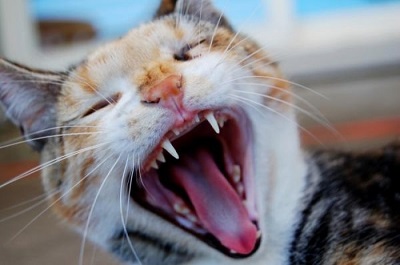Have you ever taken a good look at a cat’s tongue? If so, you may have noticed the tiny, sharp “spines” on its surface according to Science daily.
Watching her cat lick a thick, microfiber blanket and immediately become stuck tongue out was all it took to inspire Alexis Noel, a doctoral candidate in mechanical engineering, to explore the odd “spines” she noticed while helping to disentangle her cat.
If you’ve never looked closely at a cat’s tongue, imagine that it’s covered in tiny Velcro-like hooks and as it glides over fur, these hooks catch tangles and snags. “When the cat’s tongue hits a snag, it pulls on the hooks, which rotate to penetrate the snag even further.
The hook’s mobility allows the cat to better tease tangles apart,” said Noel.
“A typical hairbrush has spines that stick straight out. When hair collects on the brush it forms a thick mat that must be removed by hand,” Noel explained. “In comparison, the cat’s flexible spines make it easier to clean. When not in use, the spines on a cat tongue lie nearly flat against its surface, like overlapping shingles. This configuration provides openings in a single direction, enabling the mat of hair around the bristles to be removed with a single finger swipe. These openings face the cat’s throat and [are] also why cats swallow their hair and end up with hairballs.”
Taking the concept to the lab and using macro- and high-speed videography equipment, Noel and colleagues were able to zoom in and observe the unique shape and flexibility of the tongue spines during grooming. “In terms of shape and sharpness, it reminds me of cat claws. And this opens yet another question of why all claws are shaped so similarly,” Noel said.
To help explore their theories, the researchers became the first group to 3-D print a cat tongue mimics at 400% scale.
What did they learn? “Both the cat tongue and mimic are very good at cleaning and removing tangles in fur samples,” she said. “We also discovered that the cat tongue is self-cleaning it’s easy to remove hair beneath the spines by simply brushing the tongue from tip to end.”
This may have important implications for the world of soft robotics, in which researchers are still struggling to find ways for soft materials to grip surfaces. “The cat tongue is flexible, but it can pull apart tangles in fur,” Noel said. “So we’re trying to develop a cat tongue-inspired surface based on our 3D-printed mimic. The flexibility of cats’ tongue spines may have broad-reaching applications from an easy-to-clean hairbrush to wound cleaning within the medical field.”
N.H.Kh

